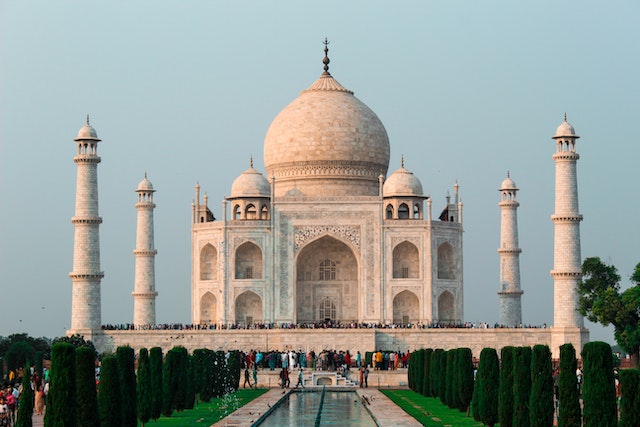
Was there really going to be a black Taj Mahal? The idea of a black Taj Mahal to go with the white one is probably just a myth as there is no actual evidence for it.
The Taj Mahal was built by the Mughal emperor, Shah Jahan, and was finished in 1653. It is a marvel of engineering and beauty. The building is almost completely symmetrical and is constructed from ivory-white marble. It is the tomb of Shah Jahan and of his favorite wife. He had it built from the middle to the end of his reign. He intended to reign for longer, but he was imprisoned by one of his sons in 1658 and he stayed locked up until he died in 1666. He was buried next to his wife.
There has long been an idea that Shah Jahan intended the white Taj Mahal to be the tomb for his wife and that he planned to build a black, identical one on the far side of the river as his own mausoleum. The story goes that he was unable to finish it because he was overthrown by his sons before he had time. The plan was to make the black Taj Mahal he mirror image of the white one and to connect them across the river with a bridge.
However, as beautiful as it would have been to have a black and a white Taj Mahal, the story is probably just a myth.
There are three pieces of evidence taken to show that construction started on the black Taj Mahal. The first is in the writings of a French traveler called Jean Baptiste Tavernier. He said that Shah Jahan began to build his own tomb, but was unable to finish it. The second piece of evidence is an area that some believe to be the site of the foundations, with black stones present. The third piece of evidence is the lack of symmetry with the burial sites in the Taj Mahal.
The first problem is that Tavernier’s account cannot be trusted. He makes mistakes; confuses people, dates, and events; and romanticizes things. More than that, he was in Agra in 1640, before the Taj Mahal was finished, and again in 1666, long after Shah Jahan had been deposed. If a black Taj Mahal had been planned, he would not have been in Agra during its construction. Not only that, but it is extremely odd that he is the only person writing at the time that makes mention of a black Taj Mahal. Not one of his contemporaries writes or even hints about a black Taj Mahal. Such an ambitious plan would have left a paper trail.
On top of that, the first Taj Mahal was finished in 1653 and Shah Jahan wasn’t imprisoned by his sons until 1658, so if he were going to build a black Taj Mahal, construction would have been fairly far along.
The second problem is that the foundations that were claimed to have been the location of the black Taj Mala turned out not to be foundations, but the wall of Mehtab Bagh, a garden complex opposite the Taj Mahal. A British archaeologist, A. C. L. Carlleyle, excavated the area in the 1890s and he believed that the pond and parts of the wall were the beginnings of construction on the black Taj Mahal. The area was excavated again in 1990 and the stones that were thought to be black, turned out to be discolored white stones.
The final problem is the lack of symmetry in the burial chamber. The Taj Mahal is perfectly symmetrical, in every respect except one: the position of the graves in the burial room. Shah Jahan’s wife is perfectly in the middle of the room, while his grave is larger and offset. This has given people the idea that he never intended to be buried here and was added as an afterthought. But this style of burial can be found in other tombs. Also, he is at the right-hand side of his wife, his tomb is the most noticeable when you enter the room, and both he and his wife are pointing toward Mecca, which shows that it was not unintentional.
So, there is not enough concrete evidence to show that Shah Jahan ever intended to build a black Taj Mahal to mirror the white one. It is a beautiful image, but it does not appear to be true. And this is what I learned today.
Sources
https://en.wikipedia.org/wiki/Black_Taj_Mahal
https://en.wikipedia.org/wiki/Shah_Jahan
